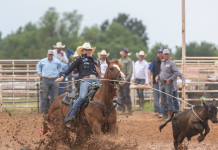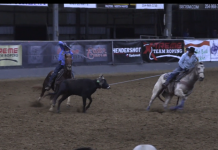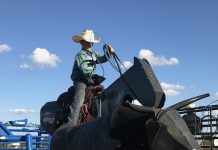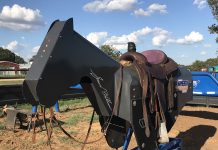With the finals are over… what do we work on now?
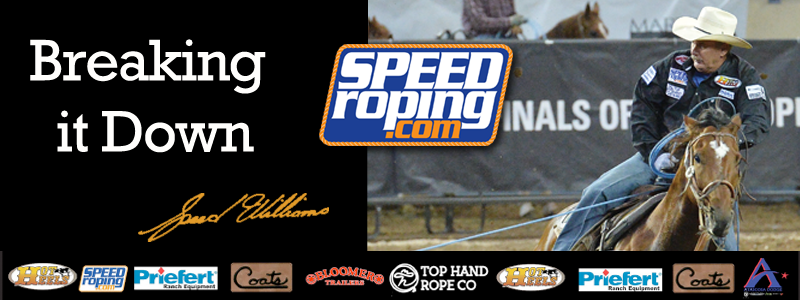
Congratulations to those who had success in Las Vegas. I take my hat off to Clay Smith for winning his second world title. I’m especially proud of Wesley Thorp for his first world championship. I’ve known him since he was very young and he’s always had a burning desire to get better. He has accomplished so much in his 24 years and is a great example for kids with a dream.
There were a lot of people who went to the finals with big dreams, but many more who drove home with their dreams shattered. It’s a new year and time to start back roping with new dreams. One of the things I always did when starting a new year, analyze my weaknesses and lay out a game plan to work on the steers that would eliminate me.
A header needs to stay sharp and what dictates much of your success is how well you react when the gates bang. At the NFR you need to be moving and “floating” to the line and reacting to what the steer does. If you get a good start, things are so much easier. Brenten Hall, at the NFR for the first time, handled the set up well. He would go towards the pin, was never in a rush, and always looked in control. His horse cowed well and allowed him to make it look easy. One thing that gets NFR headers in trouble is breaking wide and having lots of rope out. It puts your heeler in a bad position. He has to ride around the end of the swing, or corner, and throw. If he takes a swing over their back, the header is in the fence and they won’t get a flag.
There were some great runs made at the NFR this year. There were some headers that hung it on fast but didn’t help their heelers much. There were some heelers who left Las Vegas fighting their head. It is a team sport and you need to try and give your heeler the best shot possible to try and win as much as you can at the NFR. There were more teams with a chance to win the world title on the last day of the NFR than I can remember. It sure made for some excitement on Saturday night.
Many had a chance to win life changing money at the World Series Finals. I had a chance to work with some ropers at some of various locations where we had Speed Trainers set up. What I found was whether it was a #3 or #6, headers do not like trying to rope cows close to them. And as I explained over and over, we have to practice catching the cow that will take you out of the roping. Imagine you back in the box and it’s 22’ long, and you get a great start on a slow steer. But if you can’t catch him when your horse runs up close… then you’re not preparing for the cow that will let you win money.
Using the Speed Trainer is like setting up a golf simulator. You don’t want to play golf all day without working on putting. When you draw the easy steers… you need to be able to catch. It’s math, angles, and creating muscle memory to catch slow, close, easy steers. It’s also important to learn to drop two coils when you draw a runner. We need to learn to catch ALL steers. That’s one of the things I love about the Speed Trainer. I can simulate so many scenarios that can’t be replicated on the ground.
To improve you have to simulate as close to real action practice as possible. So many headers struggle with being ready to rope once they get to the cow. That include riding across the line and swinging. Often at the WSTR Finals when ropers drew the poodle and got out on top of them, the header took four or five swings and the missed. That’s the steer that will give you a chance to win something. but you have to be able to catch him.
So many things come into play, but it really starts when you nod. Being able to put weight in your stirrups, swing your rope, and be ready to rope when you get there. If your horse doesn’t cow down and you have to fight him, when you pull, you usually pick up your tip and it’s harder to catch the cow. There are many factors that go into catching the slow steer.
Between now and the next time you rope for BIG money, work on what eliminated you. Work on what cost you money, so you’ll be better prepared. Try to simulate the steer that cost you and run him over and over again. When Rich and I were rodeoing, I would always try and simulate things that went wrong so when it happened again, I was prepared. Whatever you compete on when you leave home is what you need to prepare for. Don’t score problem steers… learn to catch them so you’re better prepared during competition.
What’s new with me: I have been staying very busy with private lessons. My son loves to rope every day and when we do have a rare day off, he wants to rope. Hali’s shoulder is holding up and she’s back roping. I’m very excited with the response from customers who have purchased the Speed Trainer. I love hearing how much their horsemanship has improved and how they’re catching more. We’ll soon have some videos and testimonials on speedroping.com. The Speed Trainer built out of a desire to teach my kids and have them learn faster. I wanted a simulator that we could practice on, over and over, and work on their weaknesses and eliminate things they did wrong on their horses. When you pull on the reins by mistake, the buzzer goes off, giving you an immediate response. Instead of constantly changing bridles all times, it’s far better to learn to control your horse correctly.


